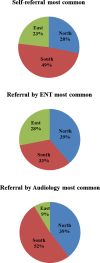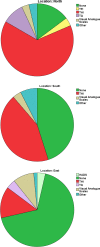Tinnitus healthcare: a survey revealing extensive variation in opinion and practices across Europe
- PMID: 31969359
- PMCID: PMC7045098
- DOI: 10.1136/bmjopen-2019-029346
Tinnitus healthcare: a survey revealing extensive variation in opinion and practices across Europe
Abstract
Tinnitus remains a scientific and clinical problem whereby, in spite of increasing knowledge on effective treatment and management for tinnitus, very little impact on clinical practice has been observed. There is evidence that prolonged, obscure and indirect referral trajectories persist in usual tinnitus care.
Objective: It is widely acknowledged that efforts to change professional practice are more successful if barriers are identified and implementation activities are systematically tailored to the specific determinants of practice. The aim of this study was to administer a health service evaluation survey to scope current practice and knowledge of standards in tinnitus care across Europe. The purpose of this survey was to specifically inform the development process of a European clinical guideline that would be implementable in all European countries.
Design: A health service evaluation survey was carried out.
Setting: The survey was carried out online across Europe.
Participants: Clinical experts, researchers and policy-makers involved in national tinnitus healthcare and decision-making.
Outcome measures: A survey was developed by the study steering group, piloted on clinicians from the TINNET network and underwent two iterations before being finalised. The survey was then administered to clinicians and policy-makers from 24 European countries.
Results: Data collected from 625 respondents revealed significant differences in national healthcare structures, use of tinnitus definitions, opinions on characteristics of patients with tinnitus, assessment procedures and particularly in available treatment options. Differences between northern and eastern European countries were most notable.
Conclusions: Most European countries do not have national clinical guidelines for the management of tinnitus. Reflective of this, clinical practices in tinnitus healthcare vary dramatically across countries. This equates to inequities of care for people with tinnitus across Europe and an opportunity to introduce standards in the form of a European clinical guideline. This survey has highlighted important barriers and facilitators to the implementation of such a guideline.
Keywords: barriers; facilitators; guidelines; health-service evaluation; pan-European; standard of care; tinnitus.
© Author(s) (or their employer(s)) 2020. Re-use permitted under CC BY-NC. No commercial re-use. See rights and permissions. Published by BMJ.
Conflict of interest statement
Competing interests: None declared.
Figures




References
Publication types
MeSH terms
LinkOut - more resources
Full Text Sources
Medical
